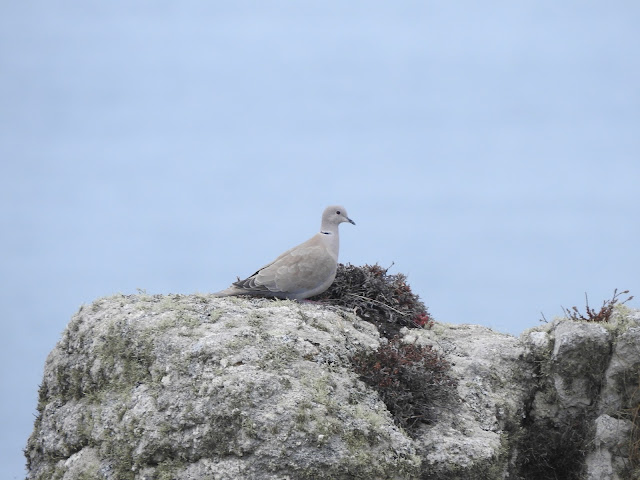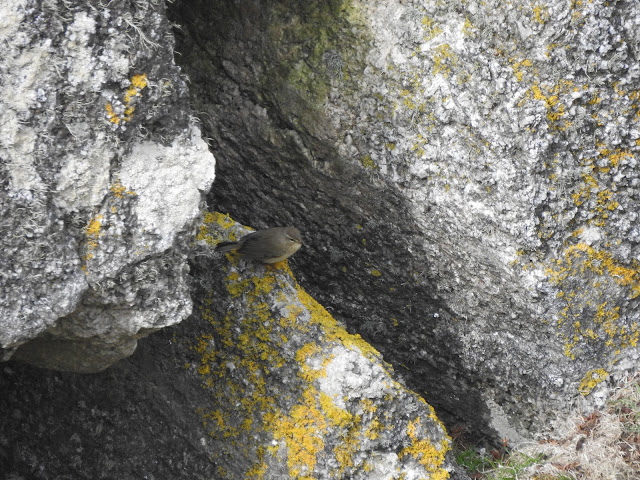11 April
Overcast with strong easterly winds.
Strong winds
in the morning meant that the morning census was quiet but migration picked up
in the afternoon with the first Whitethroat
of the year seen in Millcombe Valley. Other warblers seen included four Willow Warblers, one Chiffchaff
and 13 male and six female Blackcaps.
Other birds
seen include a Dunlin at Pondsbury,
a female Merlin, five Swallows and 122 Meadow Pipit including a
flocks of 46 and 60.
12 April
Overcast and wet in the morning with
moderate westerly winds. Warm and bright in the afternoon.
An excellent
day for birds on Lundy. The combination of morning rain and sunny afternoon
produced some interesting migrants.
Millcombe
was fairly quiet first thing with nine Willow
Warblers, six Chiffchaff and 11 male and two female Blackcaps seen. A female Ring
Ouzel was seen below Government.
Further up the island, a Yellow Wagtail and Tree Pipit flew over
Quarter Wall and four Sand Martin, two Swallows and two House Martin were recorded.
Whilst
walking up from the Landing Bay with some students a Sandwich Tern was seen
close to the shore. The walk then went to Jenny’s Cove where Warden Rosie
pointed out a small grey bird rafting with the Kittiwakes. It was distant but scope and flight views confirmed it
as a Grey Phalarope. Only the 15th Lundy record and the first April record.
At Pondsbury
were a male and two female Teal, two
calling Water Rail, a Snipe and most unusually a Sanderling. A female Merlin
was also seen.
 |
| Female Merlin, West Coast © Stuart
Cossey
|
To finish of
the day a pair of Canada Geese circled over MS Oldenburg as she
was departing and a Redwing went in
to roost in Gorse above Quarter Wall Copse.
Other
migrants seen included 91 Meadow Pipit, 20 Goldfinch and 41 Linnet.
13 April
Poor visibility all day with light
southwesterly winds
Very poor
visibility reduced the number of migrant birds seen to nine Willow Warbler, three Chiffchaff
and eight Blackcaps. A total of 39 Linnet were seen with many of these now
likely to be resident birds with a number of male singing amongst the Gorse.
Ringing
totals: 6 Willow Warbler, 4 Chiffchaff, 21 Blackcap
14 April
Overcast with light winds from the south
A busier day
after yesterday’s fog. Three Grasshopper
Warblers were hear ‘reeling’. One
was by Rocket Pole, another by Pointless Wall and the third was in Millcombe.
Other warblers recorded include 30 Willow
Warbler, 20 Chiffchaff and 45 Blackcaps. A male Redstart
was new in today and was seen foraging along the wall in South West Field.
 |
| Male Redstart, South West Field © Stuart
Cossey
|
Whilst
showing guests Puffins at Jenny’s
Cove, a Collared Dove landed on one of the Cheeses
before heading north tailed by a Peregrine.
At the end of the day a Tree Pipit was seen in Millcombe.
 |
| Collared Dove, Jenny's Cove © Stuart
Cossey
|
Other birds
of note include a Kestrel, 57 Sand Martin, 19 Swallows, 38 Goldfinch and 28 Linnet.
Ringing
totals: 15 Willow Warbler, 13 Chiffchaff, 35 Blackcap including one with a Danish ring,
1 Grasshopper Warbler, 2 Robin, 1 Linnet
15 April
Warm with continued light winds from the
south.
A busy day
for warbler migration with totals of 40 Willow
Warbler, 15 Chiffchaff, two Grasshopper
Warbler and 60 Blackcaps. Other migrating birds included six Sand Martin, five Swallows, seven House Martin and a Yellow Wagtail in Barton Field. Finches were also on the move with 38 Goldfinch, two Siskin and 53 Linnet
recorded.
A Great Northern Diver was off the East
Coast, a Sparrowhawk flew along the
Terrace and a female Merlin and Kestrel were over Ackland’s Moor.
Ringing
totals: 24 Willow Warbler, 10 Chiffchaff, 57 Blackcap,
1 Robin, 4 Goldfinch, 1 Sedge Warbler, 1 Stonechat
 |
| Sedge Warbler, Millcombe © Stuart Cossey |
16 April
Calm with slight southerly winds. The
hottest day of the year so far with temperatures hitting 16°C.
It was a
busy day in Millcombe with warblers everywhere. The final counts across the
island were 60 Willow Warblers, 30 Chiffchaff and 150 Blackcap.
A Whitethroat was also heard calling
at Pondsbury.
At Jenny’s
Cove the seabird counts are still low with 140 Kittiwake, 700 Guillemot,
200 Razorbill, 51 Puffin and 42 Fulmar. Other birds of note include a Kestrel over Ackland’s Moor, two Sand Martin, three Swallows, a House Martin and 38 Linnet.
Non avian
news a Hummingbird Hawkmoth was unfortunately found dead
in the Tavern. This typically day-flying species often migrates to the UK from
Southern Europe. Usually fast fliers, this gave a good opportunity to see the
species up close.
 |
| Hummingbird Hawkmoth © Stuart
Cossey
|
Ringing
totals: 47 Willow Warbler, 20 Chiffchaff, 104 Blackcap,
3 Grasshopper Warbler, 2 Goldfinch, 1 Song Thrush
17 April
Overcast with moderate winds from the
southwest.
On the
morning census a female Marsh Harrier was seen flying north towards
Pondsbury. It was then seen heading east over Brick Field mobbed by 12 Herring Gulls. A Collared Dove was sitting on Quarter Wall.
 |
| Female Marsh Harrier, Quarter Wall © Stuart Cossey |
It was a
slow start to the day with the majority warbler arrival picking up in the
afternoon. Totals of 50 Willow Warbler, 15 Chiffchaff and 50 Blackcap
were recorded. Though the Terrace seemed to be the place to be with Sparrowhawk, Wood Warbler, Pied Flycatcher and Goldcrest
recorded in the Willows. Other migrants include four Sand Martin, 12 Swallows and 41 Linnets.
Numbers of Wheatear have also picked up today with
20 seen away from breeding areas. There also a few individuals showing traits
of the Greenland race. These birds were larger and had brighter chests.
Greenland Wheatears have one of the longest migratory routes of any land bird,
each year traveling from Sub-Saharan Africa to Greenland or Northern Canada to
breed.
Ringing
totals: 2 Willow Warbler, 5 Chiffchaff, 17 Blackcap,
2 Goldfinch
Contributors:
S Cossey, C Dee, T Taylor, A Taylor, R Ellis, Z Wait, L Pirateque, S Prettyman,
P Murrell, D Dowding, J Cox, P Bullock


























